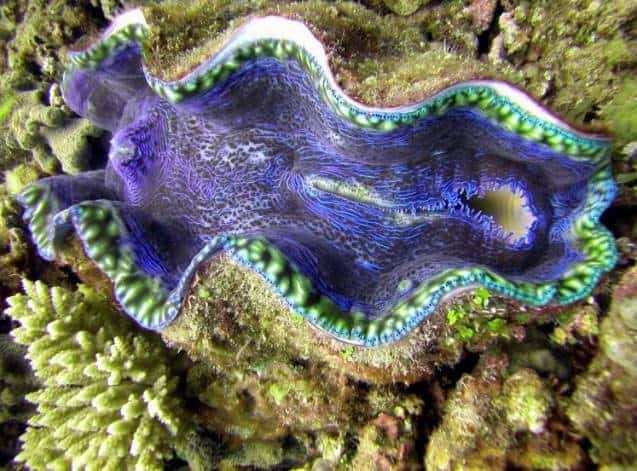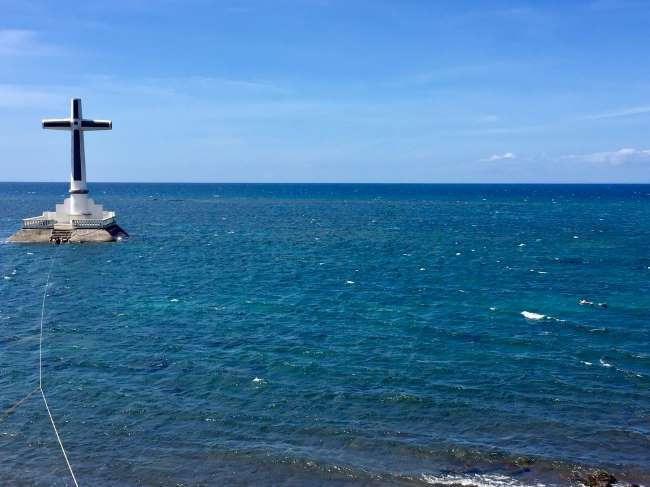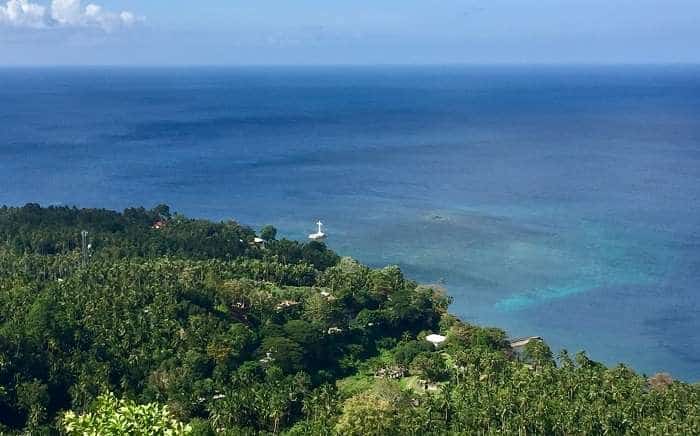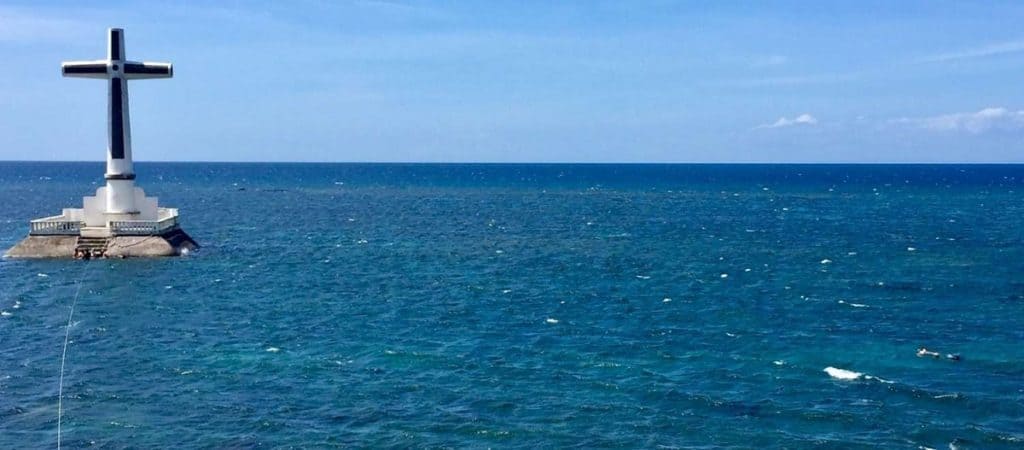Last Updated on May 27, 2023 by Ellen
Wild giant clams at Camiguin Island are breathtakingly beautiful. I could not avert my eyes from the neon details of the creatures. I studied their exquisite patterns of iridescent and pulsing biological evolution. Reds, blues, greens, yellows.
The giant clams were “open.” They wore outlines that looked electrically charged, which I later learned were eyes. Near the center, I saw spots of smooth, soft, gentle pink creatures that seemed to wink at me, even without traditional eyes.

They were in shallow water – maybe only a three feet under the surface – if that.
After a few minutes of stationary snorkeling, I lifted my face out of the water. “Wow! Thank you!” I said in an exhale to my guide; my next breath in already through my reinserted mouthpiece with my face back in the water. I could not stop looking at these novel animals.
It’s one of the times I wish I could show you what I saw. But our GoPro case broke long ago, and even if I took a picture to share with you here, it wouldn’t capture the wonder of seeing these wild giant clams, anyway. It’s an experiential thing — you have to see this if you love to snorkel.
I was dazzled by these creatures on a side trip to Camiguin Island in the Philippines. It was the highlight of my side trip with my mother-in-law, which was a highlight in our month-long stay on the Bohol Sea.
Giant clams at Camiguin Island
There are two ways to see giant clams at Camiguin Island: at the Sunken Cemetery snorkel spot, which is a reef shelf on the western part of the island, or at the giant clam sanctuary on the eastern part of the island.
To be honest, I didn’t even know about the sanctuary until a local man showed me pictures — after I had seen the wild giant clams at the Sunken Cemetery. When I saw the picture of rows of clams lined up, I was even more grateful for having seen the large creatures underwater on a coral reef. It seemed magical – authentic – the way I saw them.
The reef at Sunken Cemetery is huge. There are many types of coral – in fact there are more types of coral there in one single spot than most snorkel places I’ve seen around the planet. (Banco Chinchorro is tops, only because of its larger size — Sunken Cemetery is a small area. And I haven’t been to the Great Barrier Reef, yet.)
New to snorkeling? Read: How to snorkel the easy, cheap way – a special guide by Earth Vagabonds.
What it cost
At first I balked at the charge, and was tempted to enter the water and swim over to the area with the cross. That was a naive and foolish thought. The Sunken Cemetery is an environmentally-protected area, and the coral is so thick that I may never have found the half dozen giant clams. They were all in one place that I could have easily missed.
It’s 100 pesos per person to enter ($2); 150 pesos per group for a guide, whether you are solo or a family of four ($3). It costs another 150 pesos to rent equipment if you need it.
The tour
The Sunken Cemetery tour is basically a guide that will swim in front of you to point the path to see the best spots. We swam by different coral and fish, and some spots were really shallow. In fact, I could see where an inexperienced snorkeler would frequently kick the coral.
(Note, after my tour, I watched another guide take a family of four only half as far as I went — they appeared inexperienced to me. They never made it near the giant clams.)
The giant clams are over a coral clump and appear when you least expect it. My guide was patient, and let me take my time there. I have read some TripAdvisor reviews where guides to try to hurry people along.
Next we swam out to the large iron cross on the outskirts of the shallow shelf. This is the ‘cemetery’ portion. This is well beyond the white cross that sticks out of the water.

Camiguin Island has volcanoes, and in 1871, one eruption caused a slice of low-lying land to “slide” into the ocean. Thus, the shallow shelf. My guide stood on the iron cross out of the water on his flippers. I decided it was too slippery with algae for me to hoist myself up.
The route back to shore was different – and no less beautiful – although we did not pass any more giant clams.
Tips for the Sunken Cemetery tour
- Water shoes help, if you have them. Once afloat, you won’t need shoes, if you don’t kick the reef.
- Don’t kick the reef. As I mentioned, I’m not sure guides take fools to see the best parts.
- There is a changing room where you pay admission.
- You can leave your bag in the building where you pay admission.
- If possible, go on a calm day. My day was choppy, and I was tired after an hour of swimming from point-to-point at the reef.
- Take your time. The guide will tell you “tour” lasts 30 minutes to an hour. Take the hour.
Other Camiguin Island attractions
Spanish church ruins
A short walk from the Sunken Cemetery, there are Spanish church ruins. Entry is a few cents. These are interesting in that the old buildings are made of coral and concrete.
There is a marker near the entrance which gives the history of the place, which goes back to the 16th century.
The Old Camiguin Volcano – Stations of the Cross
This is also within walking distance to the Sunken Cemetery. It’s a steep, well-kept walkway up the side of the Old Volcano. Along the way, 15 Stations of the Cross.
Also along the way: breathtaking views to the sea. You can even see the Sunken Cemetery.

Ardent Hot Spring
Hop on a jeepney to the road leading up to the Ardent Hot Spring. From there, it’s two miles up by foot or habel-habel, or motorcycle taxi. Transportation options are limited if you don’t hire a driver for the day. The bike taxi cost 50 pesos each ($1) – or whatever you bargain. They are not official drivers, just guys willing to help tourists — for a fee.
The spring comes from Mt. Hibok Hibok, a volcano, but the water is no longer hot. There are several pool areas at the Ardent Hot Spring Resort, but some were empty during my visit, and only one was ‘warm’. It was 33.9 degrees Celsius (93 Farenheit).
Admission is 30 pesos ($.60).
Giant clams were the best!
There are other tourist spots on Camiguin Island I did not see: White Beach, Mantigue Island off of Camiguin’s east coast, that giant clam sanctuary – and more.
From my limited time on this side trip, Sunken Cemetery was the best. If we had stayed another day – I would have gone back here just to see the giant clams.
Oh, and I’m not the only one fascinated by giant clams. I found a short TED Talk by an expert. She’s funny! And also — serious. Mysterious giant clams may help the human race.
In fact, there may be a way to harvest the algae that sustain giant clams, and through that, scientists might develop a more sustainable energy resource. Biological investigations are ongoing in Palau — a country I recently half-joked to Tedly I’d like to visit.
For now, my next giant clam sighting likely will be somewhere else in the Philippines. And I can’t wait!
Thanks for reading “Breathtaking giant clams at Camiguin Island.”
You might also like:

